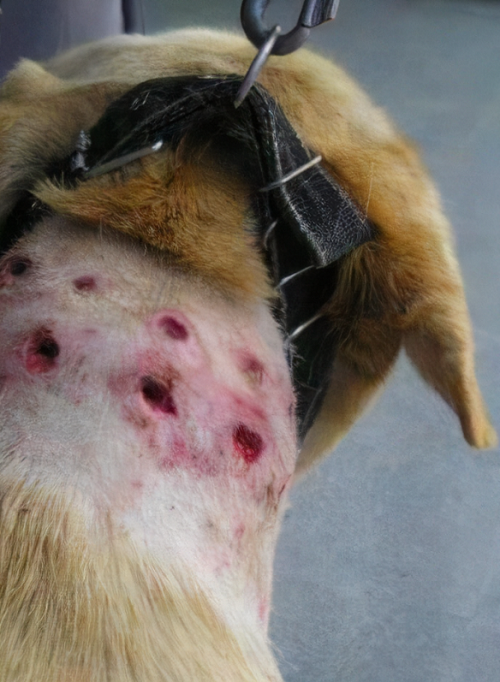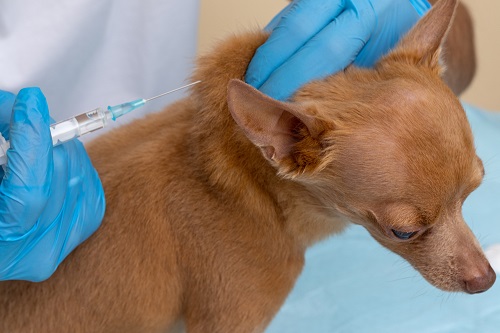Learn How to Treat Collar Sores on Dogs to heal your pet’s discomfort faster with our comprehensive guide!
Collar sores on dogs are more than just a minor discomfort; they can significantly impact the health and happiness of your furry friend. Here’s all you need to learn about How to Treat Collar Sores on Dogs, and the precautions you must undertake to prevent them in the future.
What Leads to Collar Sores on Dogs?
Collar sores on dogs, also known as collar rub or collar burn, are abrasions or irritations that occur around the neck area where a collar is typically worn. Collar sores on dogs typically result from friction or pressure due to various reasons:
- Incorrect Size or Fit: If a collar is too tight, it can rub against the dog’s skin, leading to friction-related wounds or abrasions. On the other hand, a collar that is too loose can also cause sores, as it may slide around and chafe the skin.
- Inappropriate Material: Certain materials may cause irritation or allergic reactions in some dogs, leading to sores. For instance, dogs can have reactions to synthetic materials, metals, or dyes used in the collar.
- Heavy Tags or Attachments: Weighty tags, bells, or other attachments to the collar can cause pressure sores, particularly in smaller or more delicate dogs.
- Extended Wear: If a collar is worn continuously without providing the dog’s neck some rest, it can lead to collar sores. Ensure to let the dog’s skin breathe from time to time.
- Moisture: Moisture trapped under the collar from rain, swimming, or excessive panting can soften the skin and make it more prone to damage and sores.
- Lack of Grooming: Matting of fur underneath the collar can cause discomfort and lead to sores over time.
- Skin Conditions: Existing skin conditions, such as dermatitis, can make a dog’s skin more vulnerable to developing sores.
These sores can easily become infected if not addressed promptly, leading to more serious health problems. Understanding collar sores is the first step towards prevention and treatment, ensuring your dog stays comfortable and happy in its collar.
Check out some High Fiber Dog Treats here
How to Treat Collar Sores on Dogs

With proper care and treatment, collar sores can be effectively managed and healed. Let’s learn the steps:
1. Remove the Collar
The first step in treating collar sores is to remove the collar immediately. This allows the affected area to breathe and prevents further irritation. Giving your dog a break from wearing the collar is crucial for the healing process.
2. Clean the Area
Gently clean the sore with a mild antiseptic solution or a specialized dog wound cleanser. This helps to remove any debris and bacteria from the affected area. Avoid using harsh substances and stick to products specifically designed for dogs. Use a clean cloth or cotton pad to apply the solution, being careful not to further irritate the sore.
3. Trim the Hair
If the hair around the collar sore is long, carefully trim it away using blunt-ended scissors. Trimming the hair helps to keep the area clean and prevents it from sticking to any ointments or creams that you might apply later. Be cautious not to cut the skin or cause any additional discomfort to your dog.
4. Apply a Topical Treatment
After cleaning and drying the area, apply a suitable topical treatment recommended by your veterinarian. This may include antibiotic ointments or specialized wound care products for dogs. Follow the instructions provided with the product, ensuring you apply the appropriate amount to cover the affected area. These treatments help to prevent infection and promote healing.
5. Provide Relief and Prevent Further Irritation
To provide relief and prevent your dog from aggravating the collar sore, consider using an Elizabethan collar (E-collar). This prevents your dog from scratching or licking the affected area, allowing it to heal undisturbed. Additionally, assess the fit of your dog’s collar and make necessary adjustments or consider alternative collar options, such as harnesses, to avoid further irritation.
6. Monitor And Maintain Cleanliness
Keep a close eye on the collar sore and monitor its progress. Clean the area regularly with the antiseptic solution and reapply the topical treatment as directed. It is essential to keep your dog clean and dry, avoiding activities that may aggravate the sore or cause further irritation. Regularly inspect the area for any signs of infection or worsening symptoms.
7. Consult Your Veterinarian
If the collar sore does not improve within a few days, worsens, or if your dog exhibits signs of pain, infection, or other concerning symptoms, it is crucial to consult your veterinarian. They can provide a thorough examination, offer appropriate treatment options, and provide further advice tailored to your dog’s specific needs.
Check out Can Dogs Get AIDS | HIV/AIDS and Dogs here
How to Prevent Collar Sores from Developing in Dogs?
- Ensure your dog’s collar fits properly. It should be snug, but you should be able to comfortably fit two fingers between the collar and your dog’s neck.
- Choose a collar made from a material that won’t irritate your dog’s skin. Materials like leather or soft, durable fabrics can be more comfortable for some dogs. If your dog has a known allergy, avoid collars made from that material.
- Give your dog’s neck a break by removing the collar periodically, especially when your pet is indoors or under supervision.
- Avoid attaching heavy tags or accessories to your dog’s collar, which can add pressure and cause sores over time.
- Keep your dog’s collar clean, as dirt, grime, and moisture can cause irritation. Additionally, clean and dry the area around your dog’s neck regularly.
- Ensure that your dog’s neck and the area underneath the collar are well-groomed to avoid matting and tangling of the fur, which can lead to sores.
- Check your dog’s neck regularly for any signs of redness, swelling, sores, or discomfort. If you notice any of these, adjust or replace the collar as needed and consult your vet if the symptoms persist.
- If your dog is prone to collar sores, consider alternatives like harnesses, which can distribute pressure more evenly and reduce the chance of sores.
Check out Can Dogs Get Brain Freeze? here
How Long Does it Take for Collar Sores to Heal?

The healing time for collar sores can vary depending on the severity of the sore and how well it responds to treatment. Generally, mild collar sores can start showing improvement within a few days to a week with proper care. However, more severe or infected sores may take several weeks to heal completely.
It’s important to monitor the progress of the collar sore closely. You should see a gradual reduction in redness, swelling, and discomfort. If the sore doesn’t show improvement within a reasonable time frame or if you notice any worsening symptoms, it’s best to consult with a veterinarian for further evaluation and guidance.
Check out Can a Dog Get a Cat Pregnant? here
Quick Takeaways
Collar sores can be distressing for dogs, but with proper care and treatment, they can be effectively managed and healed. Remember to remove the collar, clean the area, apply a topical treatment, provide relief, and monitor the progress. If the collar sore does not improve or if there are signs of infection or worsening symptoms, seek veterinary assistance promptly. Your veterinarian will provide expert guidance and ensure the best possible care for your furry friend’s well-being.
Check out Can Dogs Sense Evil? Find Out! here
FAQs
1. What Signs Should I Look for to Determine if My Dog’s Collar Sore is Infected?
Signs of infection in a collar sore may include increased redness, swelling, warmth around the sore, discharge or pus, a foul odor, and your dog showing signs of pain or discomfort. If you notice any of these symptoms, it’s crucial to consult a veterinarian promptly for a proper diagnosis and appropriate treatment.
2. Is it Safe to Clean Collar Sore With Hydrogen Peroxide or Other Household Antiseptics?
Using hydrogen peroxide or other household antiseptics to clean collar sores is generally not recommended. These substances can be too harsh and may further irritate the wound. It’s best to use mild antiseptic solutions specifically formulated for dogs, as recommended by your veterinarian.
3. Should I Continue to Use a Collar Once the Sore has Healed, or are There Alternative Options I Should Consider?
Once the sore has healed, you can gradually reintroduce the collar. Ensure that it fits properly, and consider using a padded collar or harness to minimize the risk of future sores. If your dog has a history of collar sores, it may be worth exploring alternative options such as harnesses, which can be a comfortable and safe alternative for walking and restraining your dog.
4. Are There Any Dietary Changes or Supplements that Can Aid in the Healing Process for Collar Sores?
A balanced and nutritious diet is essential for overall skin health and healing. Ensure that your dog’s diet includes high-quality protein, essential fatty acids, and vitamins that support skin health. Consult with your veterinarian about any specific dietary changes or supplements that may benefit your dog’s healing process.
5. Are There Any Long-term Effects or Complications Associated With Collar Sores?
If collar sores are promptly and appropriately treated, the likelihood of long-term effects or complications is generally low. However, in some cases, untreated or severe collar sores can lead to secondary bacterial infections, which may require more aggressive treatment. Additionally, repeated episodes of collar sores can cause scarring or thickening of the skin in the affected area, making it more prone to future sores.
6. Can I Use Over-the-Counter Creams or Ointments to Treat Collar Sores, or do I Need a Prescription from a Veterinarian?
For mild collar sores, over-the-counter creams or ointments designed for topical wound care can be used. Look for products specifically formulated for dogs, and follow the instructions on the packaging. However, if the collar sore is severe, doesn’t improve, or shows signs of infection, consult with a veterinarian who can prescribe appropriate medication or provide further treatment.
